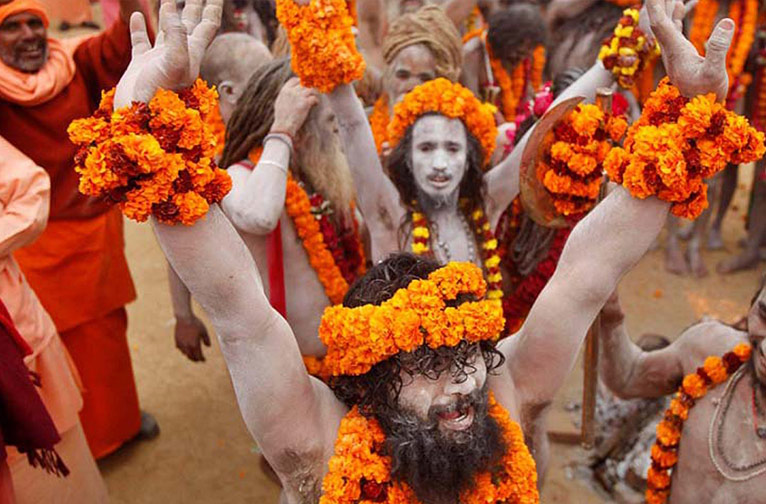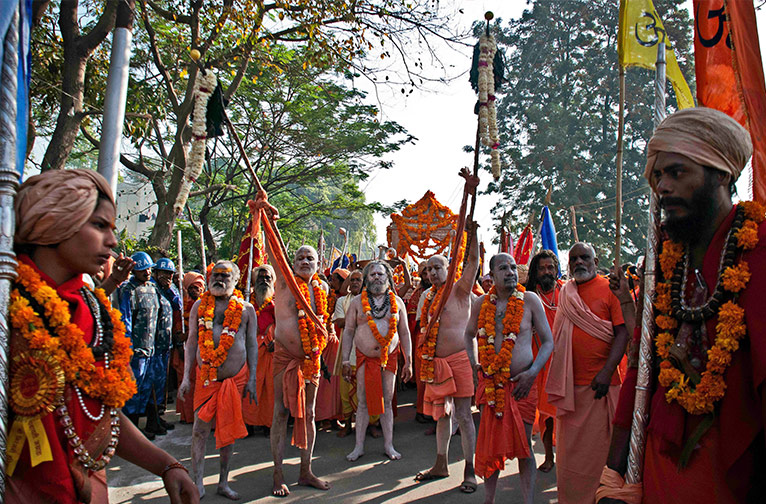The sea of pilgrims and sadhus, sages and mendicants, ascetics and saints, aspirants-Kalpavasis and priests, pandas or pilgrim guides and visitors, stretches out as far as the distant horizon on terra firma— a long distance away from the sandy banks of the holy Ganga in sacred Allahabad. Propelled with a single purpose in mind, they are all here to participate in the world’s biggest religious congregation in one place, to unburden themselves of their past sins and gain merit in the eyes of the gods.
Kumbh Mela 2025, holds the promise of once again being a spectacular extravaganza showcasing the most potent elements of the Hindu faith. The month-long Kumbh festivities kick-off when Jupiter is in Taurus (Vrishabha) and the Sun and Moon are in Capricorn (Makra) during the Hindu month of Magha (January-February).
Celebrated every twelve years, the Kumbh Mela is held alternatively in the holy cities of Haridwar, Ujjain, Nashik/Trimbakeshwar and Allahabad/Prayag. Dating back to Vedic times it is the holiest of all pilgrimages for Hindus. Tens of millions of people from all over India and abroad gather at these riverside cities to take part in the festival.
The legend behind the Kumbh Mela is a fascinating one— involving the dramatic tussle between the gods (devas) and the demons (asuras) for the pot (kumbha) of nectar of immortality (amrita).
As the tale of the Sagar Manthan goes, the devas sought to churn the primordial ocean of milk (Kshirasagar) to get their hands on the fabled pot with the nectar, which lay at the bottom. Because they had lost their powers because of a curse by Durvasa Muni the devas were forced to turn to the asuras for help to conduct this humongous task. The asuras agreed, on one condition, that they would also get a share of the nectar. And so, both parties enthusiastically went about churning the ocean for a thousand years together. The poison, halahala, released during the churning, was swallowed by and held tightly in his throat by Lord Shiva, as the strong fumes were becoming too much to handle by the devas and asuras.
But when the pot finally rose to the surface, the asuras played it dirty with the intent of keeping the amrita exclusively for themselves. Thus ensued a tussle between the asuras and the devas for twelve human years, to own the pot.
Two stories contend the outcome of this tussle.
One has it that when Lord Vishnu (as Dhanvantari) emerged with the kumbha, Jayant, the son of Lord Indra, grabbed the pot and ran away from the asuras with it. As he ran, he stopped to rest four times to catch his breath. In each place, drops of amrita fell to the earth, landing in four locations: Haridwar, Uttarakhand, on the banks of Ganges; Ujjain, Madhya Pradesh on the banks of Shipra; Nashik, Maharashtra on the banks of Godavari; Prayagraj, Uttar Pradesh, at the confluence of the Ganges, the Yamuna, and the mythical invisible Sarasvati.
The second narrative speaks of how the legendary Garuda, winged charioteer of Lord Vishnu, grabbed the pot and fled across the heavens chased by the determined asuras. A few drops of the precious elixir spilled over on four places on earth. These four blessed sites became the most important pilgrimage points for Hindus. Prayagraj, the primary Kumbh Mela site nestles by the holy confluence of the Ganga, Yamuna and mythical Saraswati.
Ultimately, as legend has it, Lord Brihaspati (Jupiter) with the help of Lord Surya (Sun) his son, Lord Shani, and the Moon, saved the kumbh from the asuras.
During the celebrations of this celestial event, it is believed, the rivers here transform into that primordial nectar at the auspicious moment when the astrological positions of the Sun, the Moon, and Jupiter are completely in sync, thus making them the most powerful). It is the ideal time for pilgrims to bathe in that essence of heightened purity, divine blessing and immortality.
All the Kumbhs
The planet Jupiter takes 12 years to transverse to complete the zodiac. The Kumbh is thus celebrated in accordance at one of these four sites after every 12 years. The Kumbh Mela takes place every 3 years, rotating between the four holy cities. The Purna Kumbh is held every 12 years and the Maha Kumbh Mela occurs every 144th years at Prayagraj. The Ardh Kumbh Mela takes place every 6th year at Haridwar and Prayagraj. The last Mahakumbh Mela was held in 2013 and the next will come up in 2025.
It is believed that by bathing in the holy waters of the Ganga River, especially during the Kumbh Mela, devotees are freed of all past karma they have committed, thus clearing the path for the attainment of moksha (liberation). As ascribed by Hindu the scriptures, taking a single bath in Ganga during the Kumbh Mela has the same effect as performing millions of other rituals.
Looking Back
The first surviving documented account of this grand festival dates back to the times of the legendary King Harshavardhana. Xuanzang (Hiuen Tsang), the Chinese traveller/scholar, on a visit during his reign mentions a great fair—Mahamoksha Parishad, initiated by the king. The report goes on to speak of the massive throngs of sages and pilgrims bathing in the sacred waters at the confluence of the holy rivers in the kingdom of Po-lo-ye-kia—identified with Prayagraj.
Kalpavasi Poojan
A unique and revered Hindu ritual performed during the Kumbh Mela Kalpavasi Poojan, by Kalpavasis who, driven by their unfettered belief in the philosophy underlying the Kumbh, stay on at the Kumbh site for a month living the austere lifestyle they always follow, of prayer and penance and only one meal a day.
It is believed that King Harsavardhana was possibly the first Kalpavasi. He would arrive at Prayag every five years and reside by the Ganga. During his sojourn here he would distribute all the wealth he had gathered in the intervening years.
On arriving at the mela grounds, the Kalpavasi head away from the main tented city on the mela grounds and live for a month in an isolated spot. Through the course of the mela they follow all the prescribed rituals of purification in the river which embraces all their sins and sorrows, meditate and pray, attend yagnas and discourses and rely on their meal, available for free, at the different akhadas and ashrams scattered across the mela grounds.
An important part of their rituals is performing the Panchkosi Parikrama to garner the full merits of the pilgrimage. A visit to the wish-fulfilling Mankameshwar Temple, they believe, must be done with a pure heart and mind for one's wishes to come true.
Prayagraj- King of Tirthas
The primary hub for the Kumbh celebrations is the holy city of rayagraj at Triveni Sangam or the confluence of the sacred Ganga, Yamuna and mythical Saraswati rivers. According to the Padma Purana the “One who bathes and drinks there where the Ganga, Yamuna and Saraswati join enjoys liberation. Of this there is no doubt”.
The Sadhus at Kumbh
The centrepiece of the festival is the participation of all the rituals of the Kumbh by the many sects of sadhus who are given exclusive treatment at the event.
Hindu Sage Adi Shankracharya first initiated the concept of the akahada in an attempt to make accessible the spiritual knowledge of the sadhus to common people and to serve as a platform for mentoring them in the rituals of the Hindu scriptures. Akhil Bhartiya Akhada Parishad, apex body for Hindu Sadhus and Sants, has identified 13 akhadas. The Juna, Mahanirvani, Niranjani, Avahan, Atal, Anand, Agni and Gudad sects are Shaivite; the Nirmohi, Digambar and Nirvani sects are Vaishnava. The Udasin and Nirmal akhadas follow the Sikh gurus. The Naga sadhus hold pre-eminence over all — kings, commoners or others sadhus in the bathing ritual at the Kumbh. It’s because they really needed this ritual of cleansing as might even kill in the name of protecting the Hindu religion and culture.
Cultural Extravaganza
The Kumbh Mela, the world’s largest public gathering and collective act of faith, serves as a fantastic platform to witness firsthand the numerous aspects of a living faith which transcends all time and place. Visitors cannot but be awed by the amazing vignettes unfolding each day at the river site. A brightly lit pop-up tented city takes care of all the accommodation, food and medical, bathing, sanitation, and security facilities, for the mighty throng of pilgrims and sadhus.


There are kathas and kirtans to attend and yagnas to witness; sages hold discourses on various spiritual tenets; darshans can be planned to receive the blessings of seers and sadhus and there are chances of lively interfaces with scholar; dance and drama troupes keep the crowds mesmerised with episodes from the Mahabharata and Ramyana; colourful processions from the different Akharas (‘Peshwai’) of sadhus on elephant backs, horses and chariots, keep up the high-octane spiritual vibe like a living thing through the course of the mela days.
The Royal Snan
The Rajyogi Snana/ Shahi Snana, attended by great throngs is a standout event at the Kumbh. There are days when only the sects of sadhus are given exclusive rights to take part in this unique bathing ritual in the sacred waters at the Triveni Sangam. Led by the naked, ash-smeared, matted -haired, sword-wielding Naga sadhus, the line of heavily garlanded sadhus wends their way to the sacred ghat.
Surrounded by mesmeric chants of Har Har Mahadev and brandishing spears and kirpans and staffs and standards, they move along the royal route, barely acknowledging the line-up of devotees agog with awe and devotion at the spectacle. Only after the last sadhu has completed his rituals and left the site are devotees permitted to carry out their own purification rituals at Triveni.
American writer Mark Twain, who witnessed this amazing spiritual-cultural extravaganza in India, was moved to share: “It is wonderful, the power of a faith like that, that can make multitudes upon multitudes of the old and weak and the young and frail enter without hesitation or complaint upon such incredible journeys and endure the resultant miseries without repining.”
If you ever get the opportunity to be visiting any of these four riverside sacred places in India during the Kumbh, do make it a point to attend what is one of the world’s greatest showcases of undiluted faith in ridding oneself of all sins and attaining the freedom of the soul to become one with the Universe.